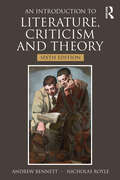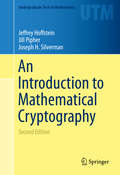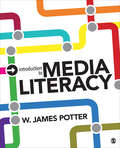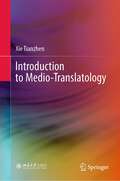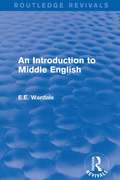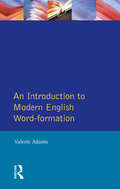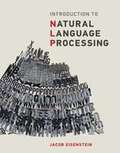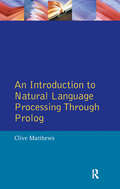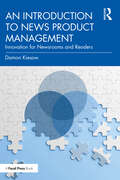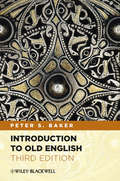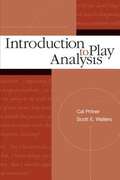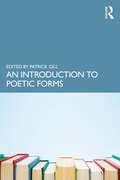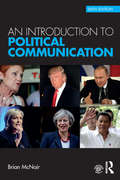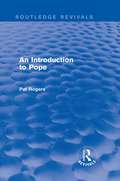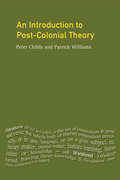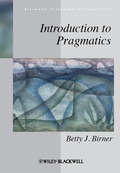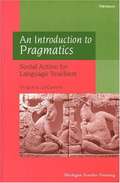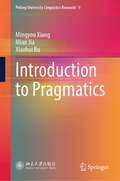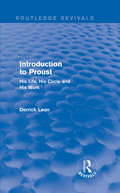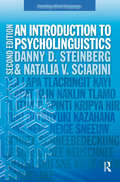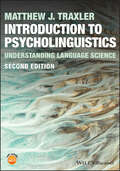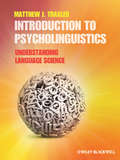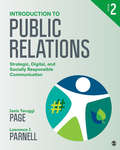- Table View
- List View
An Introduction to Literature, Criticism and Theory
by Andrew Bennett Nicholas RoyleLively, original and highly readable, An Introduction to Literature, Criticism and Theory is the essential guide to literary studies. Starting at ‘The Beginning’ and concluding with ‘The End’, chapters range from the familiar, such as ‘Character’, ‘Narrative’ and ‘The Author’, to the more unusual, such as ‘Secrets’, ‘Pleasure’ and ‘Ghosts’. Now in its sixth edition, Bennett and Royle’s classic textbook successfully illuminates complex ideas by engaging directly with literary works, so that a reading of Jane Eyre opens up ways of thinking about racial difference, for example, while Chaucer, Monty Python and Hilary Mantel are all invoked in a discussion of literature and laughter. The sixth edition has been revised and updated throughout. In addition, four new chapters – ‘Literature’, ‘Loss’, ‘Human’ and ‘Migrant’ – engage with exciting recent developments in literary studies. As well as fully up-to-date further reading sections at the end of each chapter, the book contains a comprehensive bibliography and an invaluable glossary of key literary terms. A breath of fresh air in a field that can often seem dry and dauntingly theoretical, this book will open the reader’s eyes to the exhilarating possibilities of reading and studying literature.
An Introduction to Mathematical Cryptography (Undergraduate Texts in Mathematics)
by Joseph H. Silverman Jeffrey Hoffstein Jill PipherThis self-contained introduction to modern cryptography emphasizes the mathematics behind the theory of public key cryptosystems and digital signature schemes. The book focuses on these key topics while developing the mathematical tools needed for the construction and security analysis of diverse cryptosystems. Only basic linear algebra is required of the reader; techniques from algebra, number theory, and probability are introduced and developed as required. This text provides an ideal introduction for mathematics and computer science students to the mathematical foundations of modern cryptography. The book includes an extensive bibliography and index; supplementary materials are available online. The book covers a variety of topics that are considered central to mathematical cryptography. Key topics include: classical cryptographic constructions, such as Diffie-Hellmann key exchange, discrete logarithm-based cryptosystems, the RSA cryptosystem, and digital signatures; fundamental mathematical tools for cryptography, including primality testing, factorization algorithms, probability theory, information theory, and collision algorithms; an in-depth treatment of important cryptographic innovations, such as elliptic curves, elliptic curve and pairing-based cryptography, lattices, lattice-based cryptography, and the NTRU cryptosystem. The second edition of An Introduction to Mathematical Cryptography includes a significant revision of the material on digital signatures, including an earlier introduction to RSA, Elgamal, and DSA signatures, and new material on lattice-based signatures and rejection sampling. Many sections have been rewritten or expanded for clarity, especially in the chapters on information theory, elliptic curves, and lattices, and the chapter of additional topics has been expanded to include sections on digital cash and homomorphic encryption. Numerous new exercises have been included.
Introduction to Media Literacy
by W. James PotterIntroduction to Media Literacy builds students’ media literacy step-by-step to make them more knowledgeable and engaged producers and consumers of media. In nine streamlined chapters, students learn how the mass media operate and how to use the media in better ways to achieve their own personal goals. All of the essential media topics are covered—from understanding media audiences, industries, and effects to confronting controversies like media ownership, privacy, and violence—in a concise format that keeps students focused on effectively improving their media literacy skills. Give your students the SAGE edge! SAGE edge offers a robust online environment featuring an impressive array of free tools and resources for review, study, and further exploration, keeping both instructors and students on the cutting edge of teaching and learning.
Introduction to Media Literacy
by W. James PotterIntroduction to Media Literacy builds students’ media literacy step-by-step to make them more knowledgeable and engaged producers and consumers of media. In nine streamlined chapters, students learn how the mass media operate and how to use the media in better ways to achieve their own personal goals. All of the essential media topics are covered—from understanding media audiences, industries, and effects to confronting controversies like media ownership, privacy, and violence—in a concise format that keeps students focused on effectively improving their media literacy skills. Give your students the SAGE edge! SAGE edge offers a robust online environment featuring an impressive array of free tools and resources for review, study, and further exploration, keeping both instructors and students on the cutting edge of teaching and learning.
Introduction to Medio-Translatology
by Xie TianzhenThis book offers a comprehensive introduction to medio-translatology, including its historical and literary setting, its core concept, and its practice and theory. Medio-translatology, inspired by scholarship in comparative literature and the “cultural turn” in Western translation studies, has tackled many issues which previously went unnoticed or were ignored in traditional translation studies in China; it falls within the scope of literary studies and cultural studies, extending beyond the confines of language and treating literary translations and translating as historical facts.Emerging from comparative literature, medio-translatology looks at literary translation from a new and broader perspective, and explains, with illustrative and compelling examples, that literary translation is “an act of creative treason.” The originality of this approach is also evident in its distinguishing between the history of translated literature and the history of literary translation, as well as in its addressing the nature and status of translated literature.The Chinese edition of this book, being the first of its kind and well received in China, has been hailed as a milestone in exploring translation studies in the context of comparative literature in Chinese academia, and it introduces to students and researchers alike a wide range of new thoughts and ideas.
An Introduction to Middle English
by E.E. WardaleFirst published in 1937, this book supplies a history of the living growth of the English language from Old English to the medieval period. It offers an in-depth study of the growth of vocabulary through literature and social interaction, bringing out the fact that it is chiefly words that foreign influence has affected — leaving sentence structure almost unaltered. Isolative and combinative changes in phonology, the accidence of nouns and plurals, pronouns and adverbs, and verbs are also examined in detail, along with a general overview of the features Middle English and a brief outline of each dialect’s most striking characteristics.
An Introduction to Modern English Word-Formation
by Valerie AdamsA series to meet the need for books on modern English that are both up-to-date and authoritative.For the scholar, the teacher, the student and the general reader, but especially for English-speaking students of language and linguistics in institutions where English is the language of instruction, or advanced specialist students of English in universities where English is taught as a foreign language
An Introduction to Narratology
by Monika FludernikAn Introduction to Narratology is an accessible, practical guide to narratological theory and terminology and its application to literature. In this book, Monika Fludernik outlines: the key concepts of style, metaphor and metonymy, and the history of narrative forms narratological approaches to interpretation and the linguistic aspects of texts, including new cognitive developments in the field how students can use narratological theory to work with texts, incorporating detailed practical examples a glossary of useful narrative terms, and suggestions for further reading. This textbook offers a comprehensive overview of the key aspects of narratology by a leading practitioner in the field. It demystifies the subject in a way that is accessible to beginners, but also reflects recent theoretical developments and narratology’s increasing popularity as a critical tool.
Introduction to Natural Language Processing (Adaptive Computation and Machine Learning series)
by Jacob EisensteinA survey of computational methods for understanding, generating, and manipulating human language, which offers a synthesis of classical representations and algorithms with contemporary machine learning techniques.This textbook provides a technical perspective on natural language processing—methods for building computer software that understands, generates, and manipulates human language. It emphasizes contemporary data-driven approaches, focusing on techniques from supervised and unsupervised machine learning. The first section establishes a foundation in machine learning by building a set of tools that will be used throughout the book and applying them to word-based textual analysis. The second section introduces structured representations of language, including sequences, trees, and graphs. The third section explores different approaches to the representation and analysis of linguistic meaning, ranging from formal logic to neural word embeddings. The final section offers chapter-length treatments of three transformative applications of natural language processing: information extraction, machine translation, and text generation. End-of-chapter exercises include both paper-and-pencil analysis and software implementation.The text synthesizes and distills a broad and diverse research literature, linking contemporary machine learning techniques with the field's linguistic and computational foundations. It is suitable for use in advanced undergraduate and graduate-level courses and as a reference for software engineers and data scientists. Readers should have a background in computer programming and college-level mathematics. After mastering the material presented, students will have the technical skill to build and analyze novel natural language processing systems and to understand the latest research in the field.
An Introduction to Natural Language Processing Through Prolog (Learning about Language)
by Clive MatthewsResearch into Natural Language Processing - the use of computers to process language - has developed over the last couple of decades into one of the most vigorous and interesting areas of current work on language and communication. This book introduces the subject through the discussion and development of various computer programs which illustrate some of the basic concepts and techniques in the field. The programming language used is Prolog, which is especially well-suited for Natural Language Processing and those with little or no background in computing.Following the general introduction, the first section of the book presents Prolog, and the following chapters illustrate how various Natural Language Processing programs may be written using this programming language. Since it is assumed that the reader has no previous experience in programming, great care is taken to provide a simple yet comprehensive introduction to Prolog. Due to the 'user friendly' nature of Prolog, simple yet effective programs may be written from an early stage. The reader is gradually introduced to various techniques for syntactic processing, ranging from Finite State Network recognisors to Chart parsers. An integral element of the book is the comprehensive set of exercises included in each chapter as a means of cementing the reader's understanding of each topic. Suggested answers are also provided.An Introduction to Natural Language Processing Through Prolog is an excellent introduction to the subject for students of linguistics and computer science, and will be especially useful for those with no background in the subject.
An Introduction to News Product Management: Innovation for Newsrooms and Readers
by Damon KiesowDrawing on innovations in the business of journalism, this book offers a comprehensive guide to using the human-centred design methods of product management to serve readers and bolster digital success in news organizations. An Introduction to News Product Management sets out how “product thinking” should be used in news organizations and practiced in accordance with journalistic ethics and customs. Beginning by looking at the history and theory behind the profession, this book builds a foundational understanding of what product management is and why news is a unique product. In the second unit, the author discusses how the human-centred design philosophy of product management aligns with the mission and ethics of journalism, and how that influences the view of audiences and frames strategies. The third unit of the book focuses on the daily use of product management in news organizations, providing students with a guide to its use in researching, prioritizing, and building sustainable projects that deliver news to readers and viewers. Written in an accessible style, this book features input from industry experts and draws on global examples to provide practical guidance. This is an ideal text for advanced undergraduates and graduates studying entrepreneurial journalism, media innovation, and digital media economics, as well as media professionals keen to learn more about product management and human-centred design methods.
Introduction to Old English
by Peter S. BakerFeaturing numerous updates and additional anthology selections, the 3rd edition of Introduction to Old English confirms its reputation as a leading text designed to help students engage with Old English literature for the first time. A new edition of one of the most popular introductions to Old English Assumes no expertise in other languages or in traditional grammar Includes basic grammar reviews at the beginning of each major chapter and a “minitext” feature to aid students in practicing reading Old English Features updates and several new anthology readings, including King Alfred’s Preface to Gregory’s Pastoral Care
Introduction To Play Analysis
by Cal Pritner Scott WaltersFusing a variety of influences (Aristotle, Stanislavsky, Kenneth Burke, and structuralism), this new text takes students through progressively complex levels of play reading in which they: respond to a first reading; gather information from the play (including given circumstances); interpret the characters and relate them to the conflict; and synthesize perceptions that have been revealed through analysis. Its central principle is that conflict is the essence of drama: the book lays out a systematic process for analyzing plays, relating each element to the conflict explored in each play.
An Introduction to Poetic Forms
by Patrick GillAn Introduction to Poetic Forms offers specimen discussions of poems through the lens of form. While each of its chapters does provide a standard definition of the form in question in its opening paragraphs, their main objective is to provide readings of specific examples to illustrate how individual poets have deviated from or subverted those expectations usually associated with the form under discussion. While providing the most vital information on the most widely taught forms of poetry, then, this collection will very quickly demonstrate that counting syllables and naming rhyme schemes is not the be-all and end-all of poetic form. Instead, each chapter will contain cross-references to other literary forms and periods as well as make clear the importance of the respective form to the culture at large: be it the democratising communicative power of the ballad or the objectifying male gaze of the blazon and resistance to same in the contreblazon – the efficacy of form is explored in the fullness of its cultural dimensions. In using standard definitions only as a starting point and instead focusing on lively debates around the cultural impact of poetic form, the textbook helps students and instructors to see poetic forms not as a static and lifeless affair but as living, breathing testament to the ongoing evolution of cultural debates. In the final analysis, the book is interested in showing the complexities and contradictions inherent in the very nature of literary form itself: how each concrete example deviates from the standard template while at the same time employing it as a foil to generate meaning.
An Introduction to Political Communication (Communication and Society #5)
by Brian McNairAt a time of radical shifts in power across the globe, the sixth edition of An Introduction to Political Communication examines the role of the media in the political process. Brian McNair reflects on the role of communication in key events such as the referendum vote for the UK’s withdrawal from the European Union, the rise of nationalist populism in Europe, and the victory of Donald Trump in the 2016 US presidential election. He explores the use of communication as a weapon by Islamic State and other insurgent organisations, and by Putin’s Russia in its dealings with the West, including the hacking of Democratic Party emails in 2016. McNair argues that an expanding globalised public sphere and digital media network have transformed political communication, allowing political actors, from politicians and pressure groups to trade unions and terrorist organisations, to bypass traditional, established media in communicating their messages. This sixth edition of McNair’s classic text has been comprehensively revised and updated to include: the 2016 US presidential election and Donald Trump’s rise to power; the UK’s EU referendum of 2016, the Scottish independence referendum of 2014 and the ‘snap’ UK general election of June 2017; the growing role in political communication of the internet and social media platforms such as Twitter, Facebook and YouTube, and their destabilising impact on the management of political crises all over the world including the shooting down of Malaysian Airlines MH17 and the disappearance of MH370, the Tianjin disaster in China and the Russian intervention in Ukraine; Islamic State’s global jihad, and the use of social media as an instrument of terror; the growing capacity of WikiLeaks and other online sources, such as the International Consortium of Investigative Journalists, to challenge elite control of information.
An Introduction to Pope (Routledge Revivals)
by Pat RogersIn this concise introduction to Pope’s life and work, first published in 1975, the poet’s highly successful career as a man of letters is seen against the background of the Augustan age as a whole. Pat Rogers begins by examining the relationship of the eighteenth-century writer to his audience, and discusses the role of style and versification in this. The book covers the whole of Pope’s work and includes not only the translations of Homer and such minor poems as The Temple of Fame, but also the prose, both drama and correspondence. Based on extensive research, this book will provide literature students with a greater appreciation and understanding of Pope’s verse and the ways in which he addressed his eighteenth-century context in his work.
An Introduction To Post-Colonial Theory
by Patrick Williams Peter ChildsThe first book of its kind in the field, this timely introduction to post- colonial theory offers lucid and accessible summaries of the major work of key theorists such as Frantz Fanon, Edward Said.Homi Bhabha and Gayatri Spivak. The Guide also Explores the lines of resistance against colonialism and highlights the theories of post-colonial identity that have been responsible for generating some of the most influential and challenging critical work of recent decades. Designed for undergraduates and postgraduates taking courses related to colonialisn or post-colonialism, the book summarieses the major topics and issues as well as covering the contributions of major and less familiar figures in the field.
Introduction to Pragmatics (Blackwell Textbooks in Linguistics #38)
by Betty J. BirnerIntroduction to Pragmatics guides students through traditional and new approaches in the field, focusing particularly on phenomena at the elusive semantics/pragmatics boundary to explore the role of context in linguistic communication. Offers students an accessible introduction and an up-to-date survey of the field, encompassing both established and new approaches to pragmatics Addresses the traditional range of topics – such as implicature, reference, presupposition, and speech acts – as well as newer areas of research, including neo-Gricean theories, Relevance Theory, information structure, inference, and dynamic approaches to meaning Explores the relationship and boundaries between semantics and pragmatics Ideal for students coming to pragmatics for the first time
An Introduction to Pragmatics: Social Action for Language Teachers
by Virginia LocastroAn Introduction to Pragmatics is designed for use in introductory courses in pragmatics (both undergraduate and graduate level) for students preparing to teach. By including the perspective of ESL and EFL educators, this book provides prospective teachers with an understanding of pragmatics that will help them: integrate the teaching of pragmatic competence in language programs and materials understand the problems learners have with comprehension of messages requiring cognitive processing beyond that of the spoken or written word evaluate textbooks and materials as well as assessment procedures for language proficiency assess the value of communicative language teaching practices assist learners in developing strategies to handle misunderstandings and other communication problems expand knowledge of how language is used in the world by people in everyday situations, including classrooms.
Introduction to Pragmatics (Peking University Linguistics Research #9)
by Mingyou Xiang Mian Jia Xiaohui BuThis book covers major topics in the Anglo-American tradition, including deixis, presupposition, implicature, speech acts, and (im)politeness. These key topics are illustrated with examples and case studies from various contexts such as romantic relationships, online forums, social media posts, and popular culture. The book also includes a methods chapter that offers a hands-on guide for literature search, data collection, and data analysis. This book is particularly suitable for readers who have no prior knowledge of pragmatics.
Introduction to Proust: His Life, His Circle and His Work (Routledge Revivals)
by Derrick LeonThis book, first published in 1940, provides an introduction to the life and work of the French novelist, critic, and essayist Marcel Proust, who is considered by many to be one of the greatest authors of all time. This book will be of interest to students of literature.
An Introduction to Psycholinguistics (Learning about Language)
by Danny D. Steinberg Natalia V. SciariniLearning About Language is an exciting and ambitious series of introductions to fundamental topics in language, linguistics and related areas. The books are designed for students of linguistics and those who are studying language as part of a wider course. Cognitive Linguistics explores the idea that language reflects our experience of the world. It shows that our ability to use language is closely related to other cognitive abilities such as categorization, perception, memory and attention allocation. Concepts and mental images expressed and evoked by linguistic means are linked by conceptual metaphors and metonymies and merged into more comprehensive cognitive and cultural models, frames or scenarios. It is only against this background that human communication makes sense. After 25 years of intensive research, cognitive-linguistic thinking now holds a firm place both in the wider linguistic and the cognitive-science communities.An Introduction to Cognitive Linguistics carefully explains the central concepts of categorizaÂtion, of prototype and gestalt perception, of basic level and conceptual hierarchies, of figure and ground, and of metaphor and metonymy, for which an innovative description is provided. It also brings together issues such as iconicity, lexical change, grammaticalization and language teaching that have profited considerably from being put on a cognitive basis.The second edition of this popular introduction provides a comprehensive and accessible up-to-date overview of Cognitive Linguistics: Clarifies the basic notions supported by new evidence and examples for their application in language learning Discusses major recent developments in the field: the increasing attention paid to metonymies, Construction Grammar, Conceptual Blending and its role in online-processing. Explores links with neighbouring fields like Relevance Theory Uses many diagrams and illustrations to make the theoretical argument more tangible Includes extended exercises Provides substantial updated suggestions for further reading.
Introduction to Psycholinguistics: Understanding Language Science
by Matthew J. TraxlerThe new edition of the popular introduction to the field of psycholinguistics, providing a solid foundation for understanding how people produce and comprehend language Introduction to Psycholinguistics: Understanding Language Science, Second Edition, presents a comprehensive overview of the cognitive processes involved in language acquisition, production, and comprehension. Balancing depth and accessibility, this bestselling textbook adopts a multidisciplinary approach to the study of language that incorporates perspectives from psychology, linguistics, philosophy, computer science, neurology, neurophysiology, and related fields. Student-friendly chapters explain the core components of speech, discuss how the brain receives and applies the basic building blocks of language, review leading research in psycholinguistics, describe the experimental evidence behind major theories, and more. Fully updated to incorporate recent developments in the field, the second edition of Introduction to Psycholinguistics includes a new section devoted to language and cognitive disorders, two entirely new chapters on language as aspects of autism and schizophrenia, updated illustrations and learning objectives, and new coverage of language acquisition, the cognitive neuroscience of language, bilingualism, and sign language. This valuable textbook: Reviews leading research and theory in psycholinguistics, including in-depth descriptions of the experimental evidence behind theories Describes phonology, morphology, semantics, syntax, pragmatics, and other key components of language Covers bilingualism, second-language acquisition, sign language comprehension, reading comprehension, and non-literal language interpretation Discusses cognitive disorders such as autism, aphasia, schizophrenia, and specific language impairment (SLI) Offers clear learning objectives, engaging thought exercises, chapter review questions, and step-by-step explanations of all key concepts Provides resources for instructors and students, including a companion website with review exercises, quizzes, PowerPoint slides, test banks, and other supplementary materials Introduction to Psycholinguistics: Understanding Language Science, Second Edition, is an excellent textbook for upper-level undergraduate courses in psycholinguistics, language processing, and cognitive or communication disorders, as well as related courses in psychology, linguistics, cognitive science, neuroscience, language education, and computational linguistics.
Introduction to Psycholinguistics
by Matthew J. TraxlerThis textbook offers a cutting edge introduction to psycholinguistics, exploring the cognitive processes underlying language acquisition and use. Provides a step-by-step tour through language acquisition, production, and comprehension, from the word level to sentences and dialogue Incorporates both theory and data, including in-depth descriptions of the experimental evidence behind theories Incorporates a comprehensive review of research in bilingual language processing, sign language, reading, and the neurological basis of language production and comprehension Approaches the subject from a range of perspectives, including psychology, linguistics, philosophy, computer science, neurology, and neurophysiology Includes a full program of resources for instructors and students, including review exercises, a test bank, and lecture slides, available online at www.wiley.com/go/traxler
Introduction to Public Relations: Strategic, Digital, and Socially Responsible Communication
by Janis Teruggi Page Lawrence J. ParnellIntroduction to Public Relations: Strategic, Digital, and Socially Responsible Communication presents a comprehensive introduction to the field of public relations (PR) with a focus on new media and social responsibility. Recognizing that the shifts in technology, business, and culture require a fresh approach, authors Janis Teruggi Page and Lawrence J. Parnell show students how today′s PR professionals create persuasive messages with modern technologies while working in line with the industry′s foundations. The authors balance this approach with a focus on understanding communication theory, history, process, and practice, and how all these concepts can be applied to strategic PR planning. The Second Edition features new and refreshed content throughout, including cases, chapter-opening scenarios, and profiles of both young and senior practitioners with tips and career guidance for student success. Included with this title: The password-protected Instructor Resource Site (formally known as SAGE Edge) offers access to all text-specific resources, including a test bank and editable, chapter-specific PowerPoint® slides.
